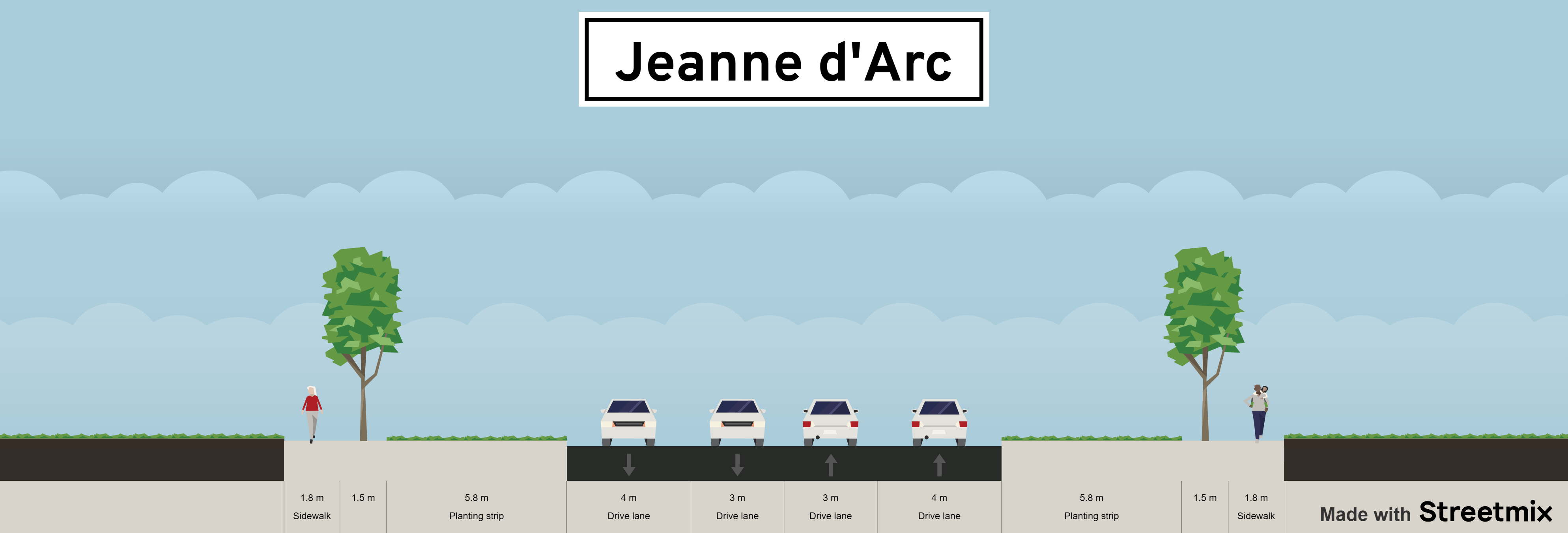My Neighbourhood
I live in a suburb of Ottawa called Orleans, and though the neighborhood is starting to work towards a modern understanding of good urban design, a lot of the transportation infrastructure in the community is based on 99% car traffic. There are affordances for other modes of transport in some places, but in many cases unless it is a brand-new change, these affordances are for leisure (like with most of the park paths), not transportation.
Top: Current streetscape; Bottom: After the redesign.


I have many qualms with the loopy, inefficient neighbourhood street layouts, and missing sidewalks, but I’ll save discussion of those for another time. Today, I want to talk about the main road granting access to my neighborhood, Jeanne d’Arc Boulevard.
Jeanne d’Arc is about the least imaginative way I could imagine designing a road in the 80s, where I could imagine having trees and some green space alongside the road would be viewed as a vast improvement over the downtown core where trees would be few and far between, and grass would be a luxury.
The Current Design
Below, I’ve mocked up the average layout of the 32+ metre boulevard streetscape with a very cool tool called Streetmix. You can see the road has 4 lanes, plus extremely generous grassy areas on either side, followed by a <1.75m sidewalk at the very edge of the boulevard (Streetmix actually calls this ‘too narrow’ and throws up warnings when you put the sidewalk in).

By the way, Streetmix also warns me that the 4m wide outer lanes of the road are considered far too wide. This boulevard was overbuilt at 14m wide for 4 lanes, presumably at a time when this was considered future-proofing for a time when it would just get busier and busier, something that has just never happened.
Drivers who use this route to commute every morning at the absolute peak of traffic would probably tell you it gets backed up occasionally, but for the remaining 99% of the time you’re much more likely to see at MOST a handful of cars than anything resembling so much as a slowdown.
On its own, this overbuilt road is underutilized, but this is true of many roads in many places all around North America. The true tragedy of this road in its current state is the missed opportunity to include other modes of transportation in its design.
It’s clear from spending any amount of time on or around this road that cars are ABSOLUTELY the priority consideration of this road. Even though the road surface itself is in pretty desperate need of a resurfacing itself, the sidewalk is in even worse shape. Not only is it extremely narrow, but in a few places, every year overgrowth from adjacent bushes actively pushes users on to the grass. It’s not uncommon to see bikes on the sidewalk as well, since there is no safe way for less comfortable or experienced riders from sharing this already narrow space with anybody who walks here.
A 32.2 m wide boulevard (all distances were measured using the measuring tool on Google Maps) is massive considering the traffic volume of all kinds here, and giving nearly half to cars (14 m), while having nearly 50% of the space dedicated to grass and trees, while all other road users are squished in to the outer <3.5 m (around 10-15% of the total road space) is frankly embarrassing.
The embarrassment only gets worse when you find out that this road connects directly to a transportation hub with the LRT system opening in 2025, and buses come along this road at MOST every 10-15 minutes at peak times (all routes combined). With wide paths, multi-modal considerations, and a little creativity, we can rethink this road to not only accommodate a way larger variety of modes of transportation, but to carry a higher volume of actual people throughout the day, instead of just calculating for the most cars the road will ever see.
The Redesign
Below is a mockup of what Jeanne d’Arc could look like with a road design that offers multiple realistic options for travel. This is just one option, with all the added space that at this point can’t realistically be used for anything but this road, there is a LOT of flexibility.

In this specific example layout, I’ve added an extra-wide sidewalk, added more trees and a bike lane in either direction. I have removed the extra car lane in each direction here as well, but there is space to keep it, although other changes to this road happening elsewhere mean that 1 lane at 40kph (instead of the current 2 lanes at 60kph) probably makes sense as the appropriate lane configuration.
With this layout, the street is much safer (it is bordered by many parks and 2 schools in a relatively short stretch), and it is designed for travel at the safe speed of 40 kph instead of requiring annoying speed traps and red-light cameras to entrap drivers with big wide lanes. One other nice feature is that the road will be much quieter for houses backing on to it at 40 kph.
Final Thoughts
To wrap up this redesign, prioritizing safe transport, via multiple modes, and in a more sustainable way, seems like a pretty clear win for the community. At most, detractors could say that driving may get a few seconds slower, maybe 1-2 minutes longer to traverse the whole length of the several km section.
Perhaps it is transparently a value judgment that these are my priorities, but the tradeoffs of designing a transportation system with redundancy and multiple good options and reducing suburban car dependency and sprawling overbuilt roadways are unquestionably positives compared to the alternative (what we have now in many cases).

